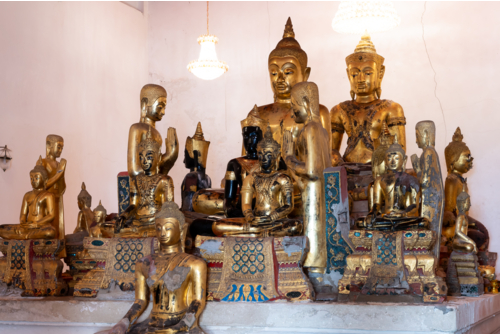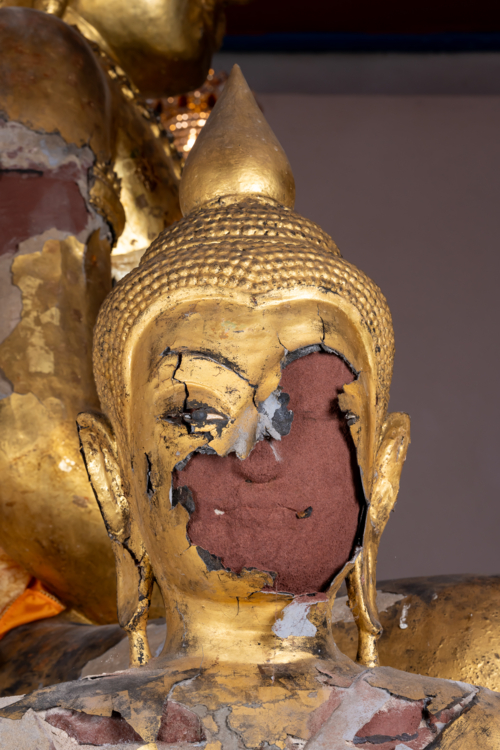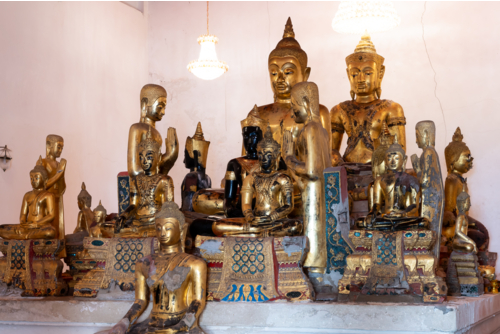Alert Info
Wat Chaeng Ron
Archaeological Site Bangkok Climate change and severe weather events Management and institutional factors
Address
, Rat Burana, Rat Burana, Bangkok, 10140
Coordinates
Latitude : 13.678323
Longitude : 100.519476
General environment and accessibility
Wat Chaeng Ron is located on the bank of the Chao Phraya River, adjacent to Khlong Chaeng Ron. It can be accessed via Rat Burana Soi 37, at the end of which the temple is situated. Upon entering the temple grounds, the Viharn (ordination hall), which houses a group of ancient Buddha images, will be the first building on the left-hand side.
Historical and local significance
Wat Chaeng Ron is an ancient with no definitive records or evidence indicating the period of its original construction. However, some elderly residents have observed that around 1918 (B.E. 2461), Phra Khru Prasit Sikkhakan (Luang Por Juan) built a new ordination hall (Ubosot) to replace the previous one, which was small, dimly lit, and located in a damp, low-lying area. During the demolition of the old Ubosot, the foundation posts made of mortar were excavated. In doing so, not only were mortar posts uncovered, but also two to three additional layers of older wooden foundation posts were found beneath them. This indicates that the ordination hall had been rebuilt several times on the same site, with each new construction being laid directly over the remnants of the former without removing the original foundations. Therefore, the current Ubosot of Wat Chaeng Ron may be the fourth or fifth to have been constructed on this same location.
Previous research studies
Ajarn Nor Na Paknam wrote in the book 'Silapa in Bangkok' that:
"The Viharn (image hall) of this temple is grand and of ancient origin. Its walls are solidly built, approximately one meter thick throughout. Both side walls are completely enclosed. The rear wall has two doors, while the front wall has three. It is considered one of the oldest and most significant architectural monuments in Thonburi. The decorative motifs on the base of the principal Buddha pedestal (Chukchi) and around the door frames are characteristic of the reign of King Narai, featuring a blend of Western and Thai styles. It is believed that during King Narai’s reign, restoration work was carried out at this temple, including the modeling of decorative stucco on both the front and rear facades."
"The rearmost Buddha image in the Viharn is exceptionally large. It is a crowned Buddha (Buddha in royal attire) wearing a traditional headdress (chatra-thereut), with facial features combining Lopburi and U-Thong styles. The central Buddha image is seated in the meditation posture (Samadhi) and made of red sandstone, like the rear image. It is also of large scale, with finely detailed hair curls—a fusion of late Lopburi and early Sukhothai styles, as seen in its oval-shaped face."
"This central Buddha image is flanked on both sides by crowned Buddha images, also adorned with headdresses, and believed to be very ancient. The innermost image faces sideways to the right of the principal Buddha. Its form and facial features resemble those of Indian deities, evoking an air of mystery and fascination."
"Originally, the Viharn was in a severely deteriorated condition. The wooden pillars inside had decayed and broken at their necks, requiring complete removal during restoration. Some sections of the Viharn walls had collapsed, and a Bodhi tree had sent its roots deep into the structure. It had to be entirely cut down in large segments before the ground could be leveled and the restoration completed, as seen today (in B.E. 2514 / 1971). The monk who oversaw the restoration did not alter or modernize the ancient components in any way, a decision of great benefit for the study of art history and archaeology. He is to be highly commended for this approach, which should serve as an exemplary model for other temples. By preserving such heritage intact, temples can retain their old artistic features for future generations to study and appreciate."
Threats type
Climate change and severe weather events, Management and institutional factors
Threats details
At present, the group of 28 Buddha images enshrined on the Chukchi pedestal in the Viharn is at high risk of deterioration. Some images show visible cracks, peeling gold leaf, and flaking surfaces. In several cases, parts of the sculptures have broken off entirely. Many of the Buddha images made from red sandstone are severely degraded, crumbling into powdery fragments. Portions of the Chukchi pedestal itself exhibit signs of decay, including cavities and hollowed-out areas.
Experts have explained that during the last major restoration—carried out approximately 40 to 50 years ago—cement plaster was applied to the outer surface of the Chukchi pedestal, and inappropriate types of mortar were used to repair the Buddha images. These interventions have hindered moisture from evaporating properly. Additionally, specialists suspect that rising sea levels have caused saline water to spread into freshwater systems, allowing salt to infiltrate the building's structure and accelerating erosion and structural damage.
Owner
Wat Chaeng Ron
Responsible or associated agencies
Wat Chaeng Ron
Fine Arts Department


